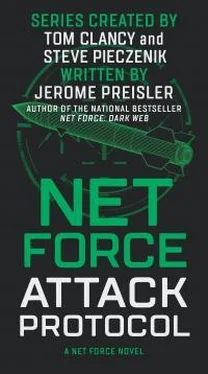There were about two dozen evidence bags on the dining table. Each showed a serial number and its collector’s name. Each bore a notation about where the evidence was being sent for analysis. Each was marked with a police case number, date, time, item description, and case type. They were organized by destination, with those on the right side of the table marked SFIU —the Sacramento Forensics Identification Unit—in black Sharpie ink. Fewer than half were on the left side of the table and marked NF .
Natasha went for a closer look, motioning for Sherron and Way to come along while Hudson stuck with Bryan in the living room.
“What do you see?” she asked the trainees.
They studied the evidence bags a moment. Over half were transparent plastic. The rest were opaque Faraday, or radio-frequency shielding bags, variously sized nylon pouches lined with metallic fabric to prevent the captured electronic devices inside them from transmitting or receiving Wi-Fi, Bluetooth, or satellite signals.
Sherron read the descriptions on the Faradays. “They’re ours,” she said. “Two phones...a tablet...three laptops. A few Jumpdrives.”
“That was quick,” Natasha said. “Again, what do you see?”
Sherron did not miss her abrupt tone. She shifted her attention from the Faradays to the clear plastic bags earmarked for the SFIU.
After a long moment, her eyebrows came up.
“Eew,” she said. “Gross.”
Unseen, Michaels smiled a little. In his white-paper evaluation of the botched Shasta Dam hacker prosecution, the piece of digital evidence Emily had just noticed was one of several to largely slip past investigators.
“What do you see?”
Sherron’s cheeks reddened. “A rubber vagina,” she said. “A sex toy.”
“Not exactly realistic,” Way said under his breath.
Natasha gave him a sharp look. “You’re sure?”
Way cleared his throat.
Natasha faced him another moment, then turned back to Sherron. “Okay,” she said. “What caught your eye about it? Creepiness aside?”
Sherron lifted the bag off the table between her thumb and forefinger, using them like tweezers.
“There are power and Wi-Fi switches,” she said. “It’s intelligent.”
“ Interactive suits me better. But you’re correct,” Natasha said and paused. “Mr. Way...what can an IoT pocket pussy tell us about its user?”
More throat clearing. “Well, he’d use it for webcam sex.”
“How? Be specific.”
“The guy would log in to a chat room—one with a live model—and give her its password. So she can control its, uh, actions during their session. While she talks dirty to him. Or, you know, does things like...”
“I know,” Natasha said. “Emily? Anything else?”
“The sessions aren’t free,” she said. “He would pay for them with a credit card or cryptocurrency. Either method is traceable, even if he’s using an alias or counterfeit plastic.”
“We can also find out when he was online. What times. And for how long,” Way said. He was plainly angling for redemption. “That would put him at the computer, and here in the house, during certain periods that might coincide with other information we have on him.”
“Also,” Emily said, “I think the model could have information to share.”
“Again...s pecifically .”
“Say he has loose lips. He might have blurted something out while he was getting a virtual f—”
Michaels turned back toward the living room. Natasha’s group was fine. He wanted to see how things were going with Bryan’s trainee.
The Hudson kid hadn’t been an outstanding student by most academic standards. He didn’t shoehorn easily into conventional measures of intelligence or do well on standardized tests. But he tried hard and showed good instincts, a doggedness that reminded Michaels of Leo Harris. He was rooting for him to succeed.
He drifted into the room just as Bry and the kid were entering from a connecting hallway. They stopped near the open front door, where the crime-scene techs were filtering out of the cottage to their van. Michaels could hear their evidence trolleys rolling and clattering over the lawn path.
“They’re done,” Bryan said to the kid. “Taking off. And they missed something big.”
“Do we know what it is?”
Bryan shrugged. “ I know,” he said. “But I’ve been to this scene, like, twelve times. It’s you that counts.”
Hudson looked around. The room was almost bare. Cleared of everything but a sofa, some chairs, and a coffee table. He seemed stumped.
“Want a tip?” Bryan asked.
“I sure won’t say no to one.”
Bryan stood next to him. “Be Gumby. Not a Blockhead.”
Hudson’s face was confused.
“Obscure cartoons-on-cable reference, sorry,” Bryan said. “The thing’s to be flexible. Don’t zero in. Just soak up what you see.”
Hudson looked around some more. Rubbed the back of his neck. Then looked around again, his eyes wandering the room. After a minute, he stepped toward the front wall. There was a smart thermostat about five feet to the right of the door. It was small and round with a digital LED window.
Michaels followed him over to the thermostat. It was two minutes before he got the call.
“Wow,” the kid said. “Smart therms work on adaptive learning. They have all kinds of sensors for reading the environment. Like near-and far-field motion detectors that record when somebody’s home. And when the place is empty.”
Bryan nodded. “What else?”
“Ambient-light sensors. They measure electric-light usage in the house and link on/off patterns to people’s everyday routines. Say, when they wake up and go to sleep.” Hudson thought for a second. “Don’t they use Wi-Fi and cellular signals to communicate with people’s devices? So they can adjust the temperature settings remotely?”
Bryan nodded again. “Tell me why that’s important.”
“When two devices communicate, you never know exactly what incidental data’s exchanged. It’s like a stream picking up sand and depositing it somewhere else. There might be info on the therm’s microprocessor that can help us.” He paused. “The hackers didn’t own this cottage, right?”
“It’s an Airbnb rental,” Bryan said. “How does it matter?”
The kid shrugged. “I just can’t see them bothering to download a thermostat-control app on their phones. They had other things on their minds.”
Bryan looked at him.
“So?” he said. “Think.”
He thought. Michaels waited. Hudson was within a hair’s breadth of finding another of the original case probe’s fatal omissions.
The kid stood there thinking ten seconds longer. Then his eyes lit up.
“IoT devices have hidden internet ports,” he said. “They send data back to their manufacturers without users ever knowing it. Then add it to information from other users’ thermostats or whatever device it might be. That’s how they aggregate data about their customers. Put it all together and turn it into metadata. They use it for product development, ad campaigns...”
He suddenly fell silent.
“Did somebody push Pause?” Bryan asked.
The kid frowned. “It just came to me. If I can figure all this out, wouldn’t the hackers have thought of it? And disabled the ports?”
Bryan shook his head a little. Doubtfully rather than dismissively.
“These ports are hard-coded,” he said. “They would have had to rework the thermostat’s whole operating system.”
“How about deleting the information from the manufacturer’s computers?”
“Not easy. Most companies use cloud storage.”
The kid shrugged again.
“They breached the controls of one of this country’s major dams.”
Читать дальше












